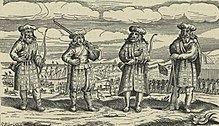
Regimental tartans are tartan patterns used in military uniforms, possibly originally by some militias of Scottish clans, certainly later by some of the Independent Highland Companies (IHCs) raised by the British government, then by the Highland regiments and many Lowland regiments of the British Army, and eventually by some military units in other countries. The earliest evidence suggesting militia uniform tartans dates to 1691, and the first certain uniform tartan was that of the Royal Company of Archers in 1713. The IHCs raised 1725–29 by the British government appear to have had one or more uniform tartans, though some later ones did not. The first true Highland regiment of the British Army was the 42nd Regiment of Foot (Black Watch) formed by amalgamation of the IHCs in 1739, and had its own consistent uniform tartan (known as Black Watch, 42nd, or Government tartan) by 1749 or 1757 at the latest. Some later Highland units also wore this tartan, while others developed minor variations on it, usually by adding bright-coloured over-checks (thin lines). Some few regiments developed their own tartans not based on Black Watch, including the 75th, 79th, Fraser Fencibles, and Loyal Clan Donnachie Volunteers. Some units developed special tartans for bandsmen and grenadiers.
Regimental tartans, along with regional or "district" ones, led to the development of clan tartans in the late 18th to mid-19th century. After clan tartans were introduced, the flow of influence reversed, and many regiments adopted clan tartans into their uniforms in the 19th century. Since the 2006 amalgamation of the surviving Scottish regiments as battalions into the Royal Regiment of Scotland, only 10 tartans are now used for British units.
- ^ Banks & de La Chapelle (2007): p. 63.
- ^ Telfer Dunbar (1979), pp. 52–53.
Cite error: There are <ref group=lower-alpha> tags or {{efn}} templates on this page, but the references will not show without a {{reflist|group=lower-alpha}} template or {{notelist}} template (see the help page).